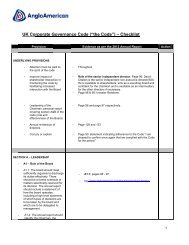Creating Value with the Future in Mind - Anglo American South Africa
Creating Value with the Future in Mind - Anglo American South Africa
Creating Value with the Future in Mind - Anglo American South Africa
Create successful ePaper yourself
Turn your PDF publications into a flip-book with our unique Google optimized e-Paper software.
Health strategy<br />
Global health<br />
Develop<strong>in</strong>g<br />
countries<br />
Communities<br />
Benchmark<strong>in</strong>g<br />
Occupational hygiene<br />
Lead<strong>in</strong>g <strong>in</strong>dicators<br />
Standards<br />
Integrated risk management<br />
We have refreshed <strong>the</strong> risk<br />
management approach <strong>with</strong><strong>in</strong> <strong>the</strong><br />
Occupational Health Way and Group<br />
Technical Standards for health to align<br />
<strong>with</strong> our new Group-wide approach<br />
to <strong>in</strong>tegrated risk management. An<br />
example of this is at our Sishen m<strong>in</strong>e,<br />
where, recognis<strong>in</strong>g that <strong>in</strong>tegrated risk<br />
management is a bus<strong>in</strong>ess-critical<br />
issue, bus<strong>in</strong>ess-improvement teams<br />
are now responsible for fatigue<br />
management.<br />
Health <strong>in</strong>formation systems<br />
The ability to capture and manage<br />
confidential health <strong>in</strong>formation is<br />
critical if we are to keep our workforce<br />
and <strong>the</strong>ir families healthy. Build<strong>in</strong>g this<br />
capability <strong>with</strong><strong>in</strong> our bus<strong>in</strong>ess was<br />
a central activity <strong>in</strong> 2012 and will<br />
cont<strong>in</strong>ue <strong>in</strong> <strong>the</strong> com<strong>in</strong>g year. Health<br />
<strong>in</strong>formation systems are <strong>the</strong> glue that<br />
holds our health activities toge<strong>the</strong>r.<br />
They allow us to capture each health<br />
transaction <strong>in</strong> onl<strong>in</strong>e records so we<br />
can track and analyse <strong>the</strong> health of all<br />
employees. They also ensure we are<br />
deliver<strong>in</strong>g a consistently high quality<br />
of service, and enable us to measure<br />
our performance (see case study on<br />
Thermal Coal’s <strong>the</strong>HealthSource on<br />
www.angloamerican.com).<br />
Health <strong>in</strong>cident report<strong>in</strong>g<br />
‘Health <strong>in</strong>cidents’ are performance<br />
<strong>in</strong>dicators <strong>in</strong> our occupational health<br />
programmes that allow us to monitor<br />
our critical controls. They <strong>in</strong>clude<br />
employee compla<strong>in</strong>ts about <strong>the</strong><br />
work<strong>in</strong>g environment, observed<br />
(or measured) failures of control<br />
mechanisms, and signs of exposure<br />
and disease identified <strong>in</strong> <strong>the</strong> medical<br />
surveillance programme. The early<br />
Families<br />
(health <strong>in</strong>surance)<br />
Employee health and wellness<br />
(<strong>in</strong>clud<strong>in</strong>g HIV/AIDS)<br />
Occupational health<br />
<strong>Anglo</strong> <strong>American</strong> Occupational Health Way (AOHW)<br />
Occupational medic<strong>in</strong>e<br />
Lead<strong>in</strong>g and lagg<strong>in</strong>g <strong>in</strong>dicators<br />
Guidel<strong>in</strong>es Support Assurance<br />
HEALTH INFORMATION SYSTEMS<br />
detection, <strong>in</strong>vestigation and correction<br />
of control failures is a way of help<strong>in</strong>g<br />
us prevent harm, as <strong>the</strong>se occur well<br />
before any visible manifestations of<br />
occupational illness. We cont<strong>in</strong>ue to<br />
see encourag<strong>in</strong>g improvement <strong>in</strong> <strong>the</strong><br />
quality of health <strong>in</strong>cident report<strong>in</strong>g<br />
across all bus<strong>in</strong>ess units.<br />
Engagement and collaboration<br />
In <strong>South</strong> <strong>Africa</strong>, <strong>the</strong> Tripartite Health<br />
and Safety Initiative between<br />
<strong>Anglo</strong> <strong>American</strong>, government and<br />
unions seeks to ensure that risk<br />
management practices are adopted<br />
at all levels of <strong>the</strong> workforce. One of<br />
<strong>the</strong> practices adopted for health<br />
management is to use <strong>the</strong> SLAM (stop,<br />
look, assess and manage) approach<br />
that is currently be<strong>in</strong>g implemented<br />
as part of broader safety-risk<br />
management.<br />
The <strong>in</strong>augural <strong>Anglo</strong> <strong>American</strong> Health<br />
Summit was held <strong>in</strong> October 2012,<br />
br<strong>in</strong>g<strong>in</strong>g toge<strong>the</strong>r one hundred of our<br />
health and safety experts from across<br />
<strong>the</strong> Group to share best practices and<br />
lessons learned between bus<strong>in</strong>ess<br />
units. This was followed <strong>in</strong> November<br />
by ano<strong>the</strong>r health conference to raise<br />
<strong>the</strong> standards of health and safety<br />
performance among our long-term<br />
contractors. Fur<strong>the</strong>rmore, we are<br />
work<strong>in</strong>g <strong>with</strong> all long-term contract<strong>in</strong>g<br />
companies work<strong>in</strong>g at our <strong>South</strong><br />
<strong>Africa</strong>n operations to ensure that <strong>the</strong>y<br />
provide a basic healthcare package<br />
for <strong>the</strong>ir employees. This will <strong>in</strong>clude<br />
diagnosis, counsell<strong>in</strong>g, care, support<br />
and treatment for HIV <strong>in</strong>fection and<br />
tuberculosis, and will be subsidised<br />
by <strong>Anglo</strong> <strong>American</strong> and delivered<br />
through our extensive network of<br />
healthcare facilities.<br />
Health<br />
<strong>in</strong>formation<br />
systems are<br />
<strong>the</strong> glue that<br />
holds our<br />
health activities<br />
toge<strong>the</strong>r.<br />
Improv<strong>in</strong>g our performance<br />
All our bus<strong>in</strong>esses are required to<br />
report on <strong>the</strong> estimated number of<br />
people potentially exposed to hazards<br />
that could result <strong>in</strong> occupational<br />
illness. We measure this aga<strong>in</strong>st set<br />
occupational exposure limits (OELs).<br />
These are legally prescribed limits,<br />
set per <strong>in</strong>dividual health risk, above<br />
which no employee may be exposed<br />
<strong>with</strong>out <strong>the</strong> use of personal protection<br />
equipment (PPE). We count <strong>the</strong><br />
number of employees work<strong>in</strong>g <strong>in</strong><br />
conditions that exceed those limits,<br />
even though <strong>the</strong>y are be<strong>in</strong>g protected<br />
<strong>with</strong> PPE. The reason we use this<br />
measure is to identify those hazards<br />
where we can improve controls and<br />
perhaps elim<strong>in</strong>ate <strong>the</strong> need for PPE.<br />
The number of employees reported to<br />
be work<strong>in</strong>g, pre-PPE, <strong>in</strong> environments<br />
<strong>with</strong> noise levels <strong>in</strong> excess of <strong>the</strong> OEL<br />
of 85 dB(A) on a daily basis dur<strong>in</strong>g<br />
2012 was approximately 44,590,<br />
as compared <strong>with</strong> 44,050 <strong>in</strong> 2011.<br />
This <strong>in</strong>crease is a result of improved<br />
report<strong>in</strong>g. Our hear<strong>in</strong>g conservation<br />
programme standard specifies <strong>the</strong><br />
management <strong>in</strong>terventions that are<br />
required to ensure exposure rema<strong>in</strong>s<br />
below <strong>the</strong> OEL.<br />
In 2012, <strong>the</strong> number of employees<br />
reported to be work<strong>in</strong>g, pre-PPE,<br />
<strong>in</strong> environments <strong>with</strong> <strong>in</strong>halable hazards<br />
at levels that exceed <strong>the</strong> <strong>in</strong>dividual<br />
OEL of different <strong>in</strong>halable hazards<br />
was approximately 6,200. Similarly,<br />
our respiratory protection programme<br />
standard requires management to<br />
reduce such exposures to below<br />
<strong>the</strong> OEL.<br />
The number of occupational disease<br />
cases reported was 170, compared<br />
<strong>with</strong> 197 <strong>in</strong> 2011. This translates to<br />
an <strong>in</strong>cidence rate of 0.189, an 8%<br />
reduction. We report disease <strong>in</strong>cidence<br />
aga<strong>in</strong>st <strong>the</strong> number of people exposed,<br />
ra<strong>the</strong>r than aga<strong>in</strong>st more commonly<br />
used bigger denom<strong>in</strong>ators such as<br />
total workforce, to give a more<br />
mean<strong>in</strong>gful assessment of <strong>the</strong> risk. It<br />
is encourag<strong>in</strong>g to see that <strong>the</strong>re were<br />
reductions <strong>in</strong> <strong>the</strong> number of new cases<br />
reported <strong>in</strong> almost all categories, <strong>in</strong><br />
particular noise-<strong>in</strong>duced hear<strong>in</strong>g loss,<br />
which dropped to 84 cases <strong>in</strong> 2012<br />
(2011: 117).<br />
Invest<strong>in</strong>g <strong>in</strong> our people<br />
<strong>Anglo</strong> <strong>American</strong> plc Susta<strong>in</strong>able Development Report 2012 49


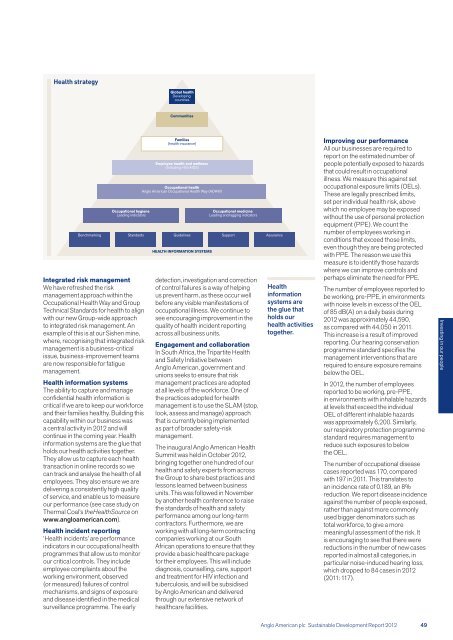
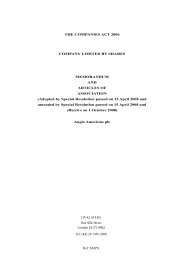
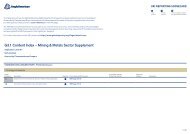
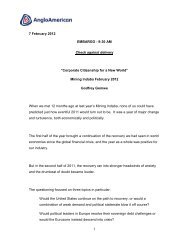
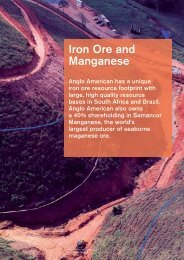

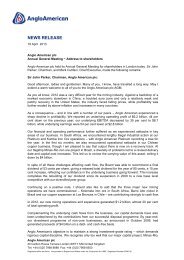
![English PDF [ 189KB ] - Anglo American](https://img.yumpu.com/50470814/1/184x260/english-pdf-189kb-anglo-american.jpg?quality=85)
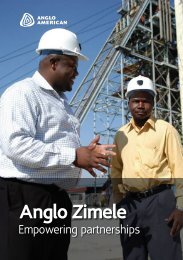

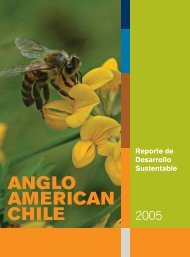

![pdf [ 595KB ] - Anglo American](https://img.yumpu.com/49420483/1/184x260/pdf-595kb-anglo-american.jpg?quality=85)
![pdf [ 1.1MB ] - Anglo American](https://img.yumpu.com/49057963/1/190x240/pdf-11mb-anglo-american.jpg?quality=85)
